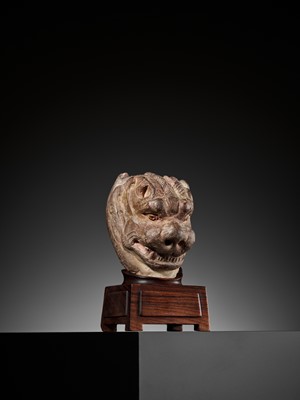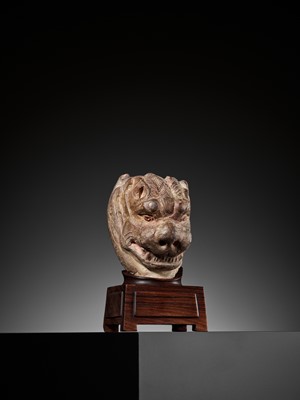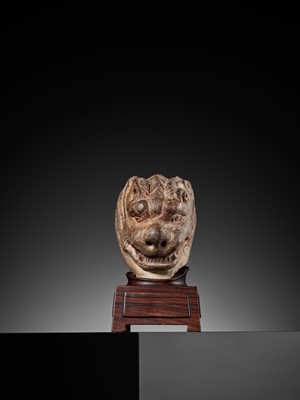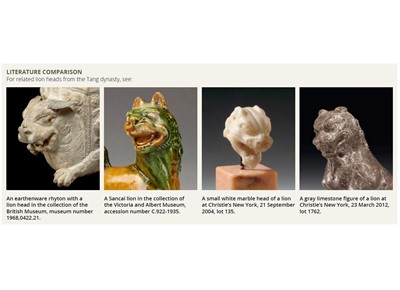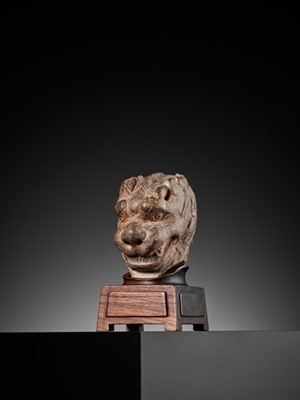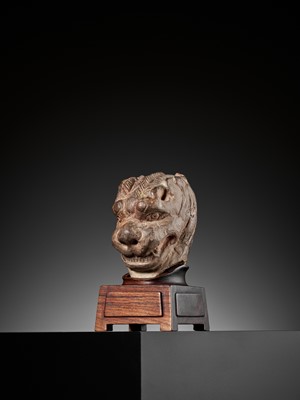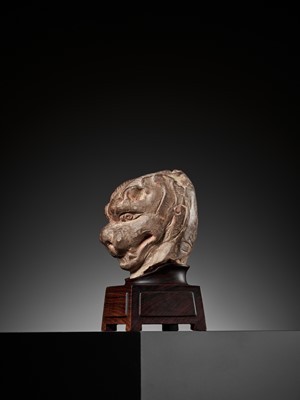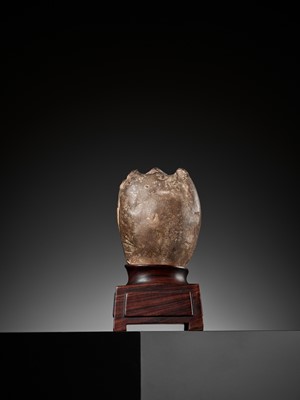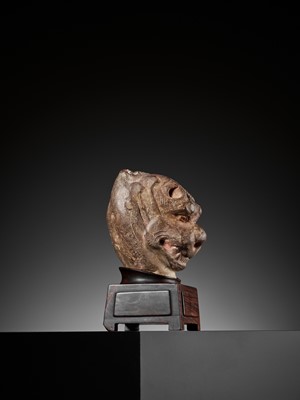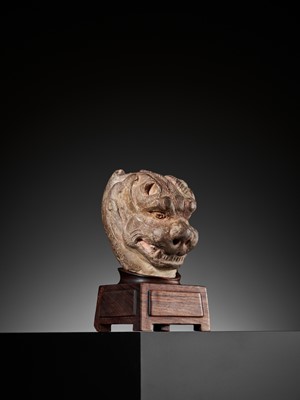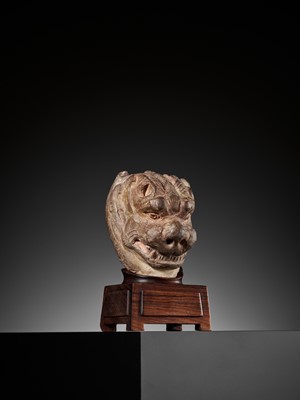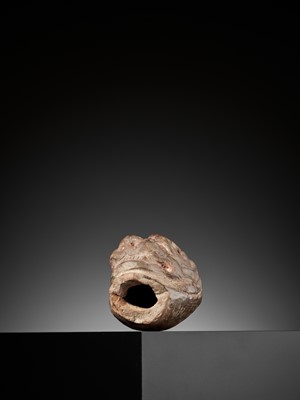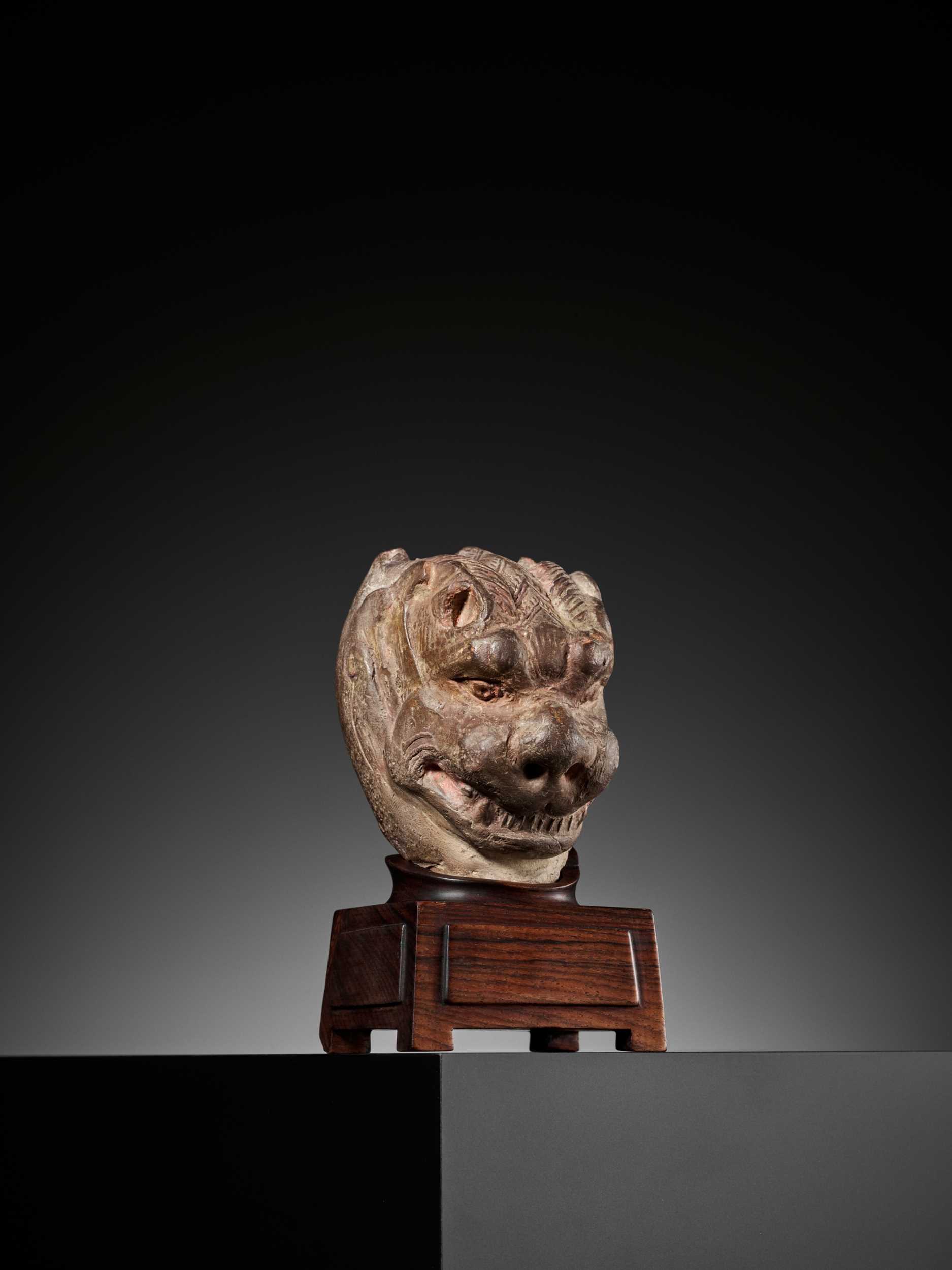15th Oct, 2021 10:00
TWO-DAY AUCTION - Fine Chinese Art / 中國藝術集珍 / Buddhism & Hinduism
143
A POTTERY HEAD OF A LION, TANG DYNASTY
唐代陶獅頭
Sold for €1,517
including Buyer's Premium
China, 618-907. The beast finely modeled with bulging eyes, a broad nose with flaring nostrils, the mouth opened revealing rows of teeth flanked by sharp fangs, the mane and ears neatly incised.
Provenance: Old Belgian private collection and thence by descent in the same family.
Condition: Excellent condition, commensurate with age, with some losses, remnants of ancient pigment. Fine, naturally grown patina and old wear from extensive handling over the centuries.
Weight: 416.7 g (excl. base)
Dimensions: Height 11 cm (excl. base) and 14.5 cm (incl. base)
With a fitted Chinese hardwood stand dating from around 1900. (2)
While lions are not native to China, some specimens apparently had reached there from the West by the Western Han period. There is evidence, for example, that lions were among the many exotic animals kept in the Han-dynasty imperial parks. Lion dancing originated during the Tang dynasty. Legend has it that the emperor had a dream one night in which a strange looking animal saved his life. The next morning, the emperor described the dream to his ministers. One minister told the emperor that the strange animal resembled a creature from the West, a lion. Lions have also had strong associations with Buddhism since the religion’s origin. The dharma, or Buddhist doctrine, is said to be spread through his roar. Since the strange animal saved the emperor in his dream, the lion quickly became a symbol of good luck throughout China.
Literature comparison: For related lion heads from the Tang dynasty, see:
- An earthenware rhyton with a lion head in the collection of the British Museum, museum number 1968,0422.21.
- A Sancai lion in the collection of the Victoria and Albert Museum, accession number C.922-1935.
- A small white marble head of a lion at Christie’s New York, 21 September 2004, lot 135.
- A gray limestone figure of a lion at Christie’s New York, 23 March 2012, lot 1762.
唐代陶獅頭
中國,618-907年。獅頭造像生動,雙眼凸出,寬鼻,鼻孔張開,大嘴露出一排排鋒利的獠牙,鬃毛和耳朵細節鮮明。
來源:比利時私人收藏,保存在同一家族至今
品相:狀況極佳,與年代相符,有一些缺損,古代顔料殘餘。幾個世紀來自然生長的細膩包漿和舊磨損。
重量:416.7 克 (不含底座)
尺寸:高11 厘米 (不含底座),14.5 厘米 (含底座)
配套大約1900年代的中國硬木底座 (2)
文獻比較:來自唐代的相似獅頭,見:
• 陶獅頭見British Museum, museum number 1968,0422.21.
• 三彩獅子見Victoria and Albert Museum, accession number C.922-1935.
• 小大理石獅頭見紐約佳士得2004年9月21日, lot 135.
• 石灰石獅子像見紐約佳士得2012年3月 23日 lot 1762.
China, 618-907. The beast finely modeled with bulging eyes, a broad nose with flaring nostrils, the mouth opened revealing rows of teeth flanked by sharp fangs, the mane and ears neatly incised.
Provenance: Old Belgian private collection and thence by descent in the same family.
Condition: Excellent condition, commensurate with age, with some losses, remnants of ancient pigment. Fine, naturally grown patina and old wear from extensive handling over the centuries.
Weight: 416.7 g (excl. base)
Dimensions: Height 11 cm (excl. base) and 14.5 cm (incl. base)
With a fitted Chinese hardwood stand dating from around 1900. (2)
While lions are not native to China, some specimens apparently had reached there from the West by the Western Han period. There is evidence, for example, that lions were among the many exotic animals kept in the Han-dynasty imperial parks. Lion dancing originated during the Tang dynasty. Legend has it that the emperor had a dream one night in which a strange looking animal saved his life. The next morning, the emperor described the dream to his ministers. One minister told the emperor that the strange animal resembled a creature from the West, a lion. Lions have also had strong associations with Buddhism since the religion’s origin. The dharma, or Buddhist doctrine, is said to be spread through his roar. Since the strange animal saved the emperor in his dream, the lion quickly became a symbol of good luck throughout China.
Literature comparison: For related lion heads from the Tang dynasty, see:
- An earthenware rhyton with a lion head in the collection of the British Museum, museum number 1968,0422.21.
- A Sancai lion in the collection of the Victoria and Albert Museum, accession number C.922-1935.
- A small white marble head of a lion at Christie’s New York, 21 September 2004, lot 135.
- A gray limestone figure of a lion at Christie’s New York, 23 March 2012, lot 1762.
唐代陶獅頭
中國,618-907年。獅頭造像生動,雙眼凸出,寬鼻,鼻孔張開,大嘴露出一排排鋒利的獠牙,鬃毛和耳朵細節鮮明。
來源:比利時私人收藏,保存在同一家族至今
品相:狀況極佳,與年代相符,有一些缺損,古代顔料殘餘。幾個世紀來自然生長的細膩包漿和舊磨損。
重量:416.7 克 (不含底座)
尺寸:高11 厘米 (不含底座),14.5 厘米 (含底座)
配套大約1900年代的中國硬木底座 (2)
文獻比較:來自唐代的相似獅頭,見:
• 陶獅頭見British Museum, museum number 1968,0422.21.
• 三彩獅子見Victoria and Albert Museum, accession number C.922-1935.
• 小大理石獅頭見紐約佳士得2004年9月21日, lot 135.
• 石灰石獅子像見紐約佳士得2012年3月 23日 lot 1762.
Zacke Live Online Bidding
Our online bidding platform makes it easier than ever to bid in our auctions! When you bid through our website, you can take advantage of our premium buyer's terms without incurring any additional online bidding surcharges.
To bid live online, you'll need to create an online account. Once your account is created and your identity is verified, you can register to bid in an auction up to 12 hours before the auction begins.
Intended Spend and Bid Limits
When you register to bid in an online auction, you will need to share your intended maximum spending budget for the auction. We will then review your intended spend and set a bid limit for you. Once you have pre-registered for a live online auction, you can see your intended spend and bid limit by going to 'Account Settings' and clicking on 'Live Bidding Registrations'.
Your bid limit will be the maximum amount you can bid during the auction. Your bid limit is for the hammer price and is not affected by the buyer’s premium and VAT. For example, if you have a bid limit of €1,000 and place two winning bids for €300 and €200, then you will only be able to bid €500 for the rest of the auction. If you try to place a bid that is higher than €500, you will not be able to do so.
Online Absentee and Telephone Bids
You can now leave absentee and telephone bids on our website!
Absentee Bidding
Once you've created an account and your identity is verified, you can leave your absentee bid directly on the lot page. We will contact you when your bids have been confirmed.
Telephone Bidding
Once you've created an account and your identity is verified, you can leave telephone bids online. We will contact you when your bids have been confirmed.
Classic Absentee and Telephone Bidding Form
You can still submit absentee and telephone bids by email or fax if you prefer. Simply fill out the Absentee Bidding/Telephone bidding form and return it to us by email at office@zacke.at or by fax at +43 (1) 532 04 52 20. You can download the PDF from our Upcoming Auctions page.
How-To Guides
How to Create Your Personal Zacke Account
How to Register to Bid on Zacke Live
How to Leave Absentee Bids Online
How to Leave Telephone Bids Online
中文版本的操作指南
创建新账号
注册Zacke Live在线直播竞拍(免平台费)
缺席投标和电话投标
Third-Party Bidding
We partner with best-in-class third-party partners to make it easy for you to bid online in the channel of your choice. Please note that if you bid with one of our third-party online partners, then there will be a live bidding surcharge on top of your final purchase price. You can find all of our fees here. Here's a full list of our third-party partners:
- 51 Bid Live
- EpaiLive
- ArtFoxLive
- Invaluable
- LiveAuctioneers
- the-saleroom
- lot-tissimo
- Drouot
Please note that we place different auctions on different platforms. For example, in general, we only place Chinese art auctions on 51 Bid Live.
Bidding in Person
You must register to bid in person and will be assigned a paddle at the auction. Please contact us at office@zacke.at or +43 (1) 532 04 52 for the latest local health and safety guidelines.
